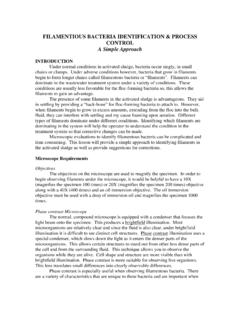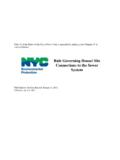Transcription of Julie Sievers Iowa DNR Field Office 3 - Iowa Rural Water ...
1 Julie Sievers iowa DNR Field Office 3. Ammonia, NH3 Organic Nitrogen, TKN. Nitrite, NO2. Nitrate, NO3. Monochloramine, NH2Cl Dichloramine, NHCl2 Combined Chlorine Trichloramine, NCl3. Free Chlorine, OCl- (hypochlorite) or HOCl (hypochlorous acid) dependent on pH. Total Chlorine = Free + Combined Free Available Ammonia, need to know form (NH3 or NH3-N). Do you know which of these are present in your system? Chlorine typically added as gas chlorine or sodium hypochlorite (liquid chlorine). Disassociates based on pH (and temperature).
2 Chlorine Hypochlorous Acid Hypochlorite Ion If you add ammonia or have it present in the raw Water , these reactions occur: Monochloramine Dichloramine Trichloramine There are competing reactions NaOCl + H2O HOCl + NaOH Liquid chlorine Cl2 + H2O HOCl + Cl- + H+ Gas chlorine NH3 + HOCl NH2Cl + H2O Monochloramine NH2Cl + HOCl NHCl2 + H2O Dichloramine Trichloramine NHCl2 + HOCl NCl3 + H2O. For typical, traditional chloramination, the system adds chlorine and ammonia The system can control both chlorine feed rate and ammonia feed rate Chlorine is added first, then ammonia In systems with naturally occurring ammonia, chloraminating due to ammonia in source Water System can control chlorine feed rate BUT have no to limited ability to change or control ammonia level Do you have ammonia in your raw Water ?
3 Do you add ammonia? Ammonia reacts with chlorine to form monochloramine, dichloramine, and trichloramine Formation is dependent on the pH and chlorine to ammonia ratio Monochloramine, dichloramine, and trichloramine are measured as a part of the total chlorine residual and are weak disinfectants Trichloramine = Nitrogen trichloride Monochloramine and dichloramine exist together at pH of to Chlorine to ammonia ratio determine which is formed Dichloramine and trichloramine cause taste and odor problems Small amounts of trichloramines may exist past the breakpoint and may also cause taste and odor problems From Bob Spon, OpFlow Article, June 2008.
4 Ammonia results from a certified lab are for total ammonia Free ammonia testing must be done immediately and is done on-site Total chlorine = free + combined Combined chlorine = monochloramine +. dichloramine + trichloramine Free chlorine = hypochlorite ion +. hypochlorous acid Free chlorine in the presence of chloramines is false free Minimum levels dependent on where you are at on the curve Minimum of mg/L free chlorine residual if on the breakpoint side of the curve Minimum of mg/L total chlorine residual if chloraminating Maximum of mg/L total chlorine From Bob Spon, OpFlow Article, June 2008.
5 Determine where you are at on the curve Measure free chlorine immediately and at 30 second intervals to 2 minutes Are the readings stable? Do the readings increase? If so, you are on the chloramine side of the curve & do NOT have free chlorine. This is often referred to as false free Measure total chlorine residual Rule of thumb is if the free residual is stable and 80% of total, you are on the breakpoint side and have true free residual False Free Chlorine Residuals All in mg/L. Zero Immediately = 30 seconds = 60 seconds = 90 seconds = 120 seconds = Ammonia, NH3.
6 Ammonium ion, NH4. In neutral or acidic natural waters, ammonia is present as ammonium ion Nitrite, NO2. Nitrate, NO3. Organic Nitrogen, TKN. Pidwirny, M. (2006). "The Nitrogen Cycle". Fundamentals of Physical Geography, 2nd Edition. Ammonia Treatment Storage and in Well Plant Distribution Ammonia, Ammonia, Nitrite or Nitrite or Nitrate Nitrate depending on depending on conditions conditions Nitrosomas and Nitrobacter Naturally occurring in iowa When the nitrogen present in the well is ammonia it is not from surface source Surface source is nitrified to nitrate before reaches aquifer = nitrate in well.
7 Not ammonia Believe from mineralization of organic material present from when aquifer was formed Mineralization of organic matter to ammonium by microorganisms in presence of organic carbon sources in an anaerobic (without oxygen). environment Most of iowa was shallow seas Found in all aquifers Levels of 1 to 5 mg/L common DNR/UHL study GSB data USGS data Ambient Water quality data DNR 2013 study Raw Water monitoring Levels as high as 9 mg/L. Ammonia is NOT regulated in iowa DNR, UHL, CHEEC. CHEEC = Center for Health Effects From Environmental Contamination Sampled 233 municipal wells for ammonia, nitrite, nitrate, pH, temperature, and perchlorate in summer 1999.
8 Nitrite found in 2 well samples Ammonia Levels in 233 Wells: 114 samples below detectable 68 samples with <1 mg/L. 31 samples between 1 and mg/L. 16 samples between and 5 mg/L. 4 samples >5 mg/L. Data from GSB and USGS groundwater monitoring program 1982 1996. 2,529 samples from 1,158 different wells Not all sampled for nitrogen compounds each sampling period 841 wells sampled for nitrogen compounds Range < to mg/L. 3000+ samples 1984 - 2010. Various aquifers 1348 samples with ammonia below the detection level ( mg/L).
9 1603 samples with ammonia Levels range from 11 mg/L. 66 samples All aquifers, known well construction 17 samples with ammonia levels below detection ( mg/L). 49 samples with ammonia levels between mg/L. Ammonia has a huge chlorine demand Need to know what form of disinfectant you are using Must meet minimum levels to protect public health Taste and odor issues Nitrification Disinfection byproducts violations or issues TTHM/HAA5 for free chlorine; Nitrosamines for chloramines Water quality impacts Do you know where you are at on the curve?
10 Where are You on the BP Curve? Test Results = mg/L total chlorine Courtesy of Hach disinfection series What else do you need to know? From Bob Spon, OpFlow Article, June 2008. What do we need to measure? Where is the best spot to test for it? What results are we looking for? What do we do if we don't get them? Free chlorine residual Determine if true or false free For systems adding ammonia, measure free chlorine prior to ammonia addition to determine how much ammonia to add Total chlorine residual Free Ammonia For chloraminating systems to determine location on the curve Monochloramine This is the target disinfectant for chloraminating systems Total residual = Monochloramine In systems that add ammonia.





